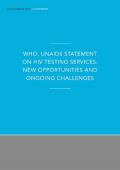What's New
Displaying results 2001 - 2010 of 4914

Resource | Publications,
The report provides a comprehensive and up-to-date assessment of the TB epidemic, and of progress in prevention, diagnosis and treatment, at global, regional and country levels. This is done in the context of recommended global TB strategies and associated targets, as well as broader development goals set by the United Nations.
WHO has published a global TB report every year since 1997.

Resource | Publications,
This document is an action framework designed for countries to plan tuberculosis (TB) services for groups within their populations that are more vulnerable, underserved or at higher risk of infection and illness related to TB. These groups are referred to as key populations in the Stop TB Partnership Global Plan to END TB. They are key because addressing TB issues they face is critical to the overall goal of ending the epidemic for the entire population. Key populations vary by country and include people with increased exposure to TB due to where they live or work, people with limited access to quality TB services, and people at greater risk due to biological or behavioural factors.
The Global Plan to END TB calls for a paradigm shift, including how TB services are organized, managed and funded, moving:
- From passive to active case finding with strong engagement of civil society including key
- population-led networks and organizations
- From vertical to integrated service delivery systems
- From small incremental to accelerated substantial financial investments

Resource | Presentations,
-Commitments on ending AIDS and Fast-Track targets
-Regional overview
-Public health model of HIV
-How HIV response model can benefit other communicable diseases

Resource | Presentations,
From barriers to bridges: Increasing access to HIV and other
health services for trans people in Asia
20 September 2017
Bangkok, Thailand

Resource | Tools,
APCASO’s Strengthening CRG Concepts Tool is meant for civil society members of Country Coordinating Mechanism (CCM), a multi-stakeholder governance structure composed of representatives from different stakeholders of the three diseases, such as government agencies, private sector groups, civil society organizations, communities affected by or living with the diseases, academics, and international and multilateral development institutions. The objective is to build capacity of community and civil society members on community engagement, human rights, and gender equality in relation to meaningful country dialogues, planning and budgeting, and program design in Concept Note submissions to the Global Fund for the three diseases (HIV, TB, and malaria).

Resource | Presentations,
Presented by Eamonn Murphy
Regional Director
UNAIDS Asia and the Pacific
at From barriers to bridges: Increasing access to HIV and other health services for trans people in Asia. 20 September 2017, Bangkok, Thailand

Resource | Guidelines,
Antiretroviral therapy using dolutegravir has several advantages over other regimens, including clinical superiority, improved side-effect profile, and reduced risk of viral resistance.
This is the first time this regimen will be offered as an affordable, generic, fixed-dose combination, which will increase access for millions of people living with HIV in low- and middle-income countries. Below are a set of key messages and questions and answers to guide communications around the announcement and respond to media inquiries.

Resource | Laws and Policies,
The policy on HIV Counseling and Testing is updated to provide quality standards in the conduct of HIV testing services consistent with the 2015 WHO Consolidated Guidelines on HIV Testing Services. This also to ensure wider access to HIV treatment in the country.

Resource | Publications,
Among key populations, who have low uptake of other testing options, reported benefits include privacy, convenience, pain-free testing, and ease of use. In 2016, the World Health Organization (WHO) released new guidelines recommending that HIVST should be offered as an additional approach to HIV testing services (strong recommendation, moderate quality of evidence). Although self-tests achieve acceptable sensitivity and specificity, all reactive and invalid results must be linked for confirmatory testing because self-tests are meant to be screening tests.

Resource | Publications,
HIV testing services are an essential gateway to HIV prevention, treatment, care and support services. The World Health Organization (WHO) and the Joint United Nations Programme on HIV/AIDS (UNAIDS) endorse and encourage universal access to knowledge of HIV status. Increased access to and uptake of HIV testing is central to achieving the 90–90–90 targets endorsed in the 2016 United Nations Political Declaration on Ending AIDS.





